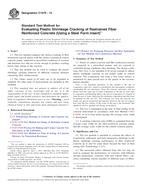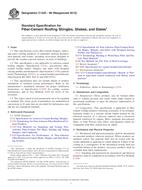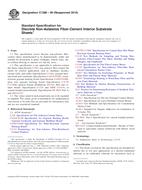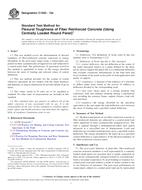We need your consent to use the individual data so that you can see information about your interests, among other things. Click "OK" to give your consent.
ASTM C1579-13
Standard Test Method for Evaluating Plastic Shrinkage Cracking of Restrained Fiber Reinforced Concrete (Using a Steel Form Insert)
STANDARD published on 1.4.2013
The information about the standard:
Designation standards: ASTM C1579-13
Note: WITHDRAWN
Publication date standards: 1.4.2013
SKU: NS-11909
The number of pages: 7
Approximate weight : 21 g (0.05 lbs)
Country: American technical standard
Category: Technical standards ASTM
The category - similar standards:
Annotation of standard text ASTM C1579-13 :
Keywords:
crack width, evaporation, fiber-reinforced concrete, plastic shrinkage cracking, restrained shrinkage cracking, ICS Number Code 91.100.40 (Products in fibre-reinforced cement)
Additional information
| Significance and Use | ||||||||||
|
4.1 The test method is intended to evaluate the effects of evaporation, settlement, and early autogenous shrinkage on the plastic shrinkage cracking performance of fiber reinforced concrete up to and for some hours beyond the time of final setting (See Terminology C125). 4.2 The measured values obtained from this test may be used to compare the performance of concretes with different mixture proportions, concretes with and without fibers, concretes containing various amounts of different types of fibers, and concretes containing various amounts and types of admixtures. For meaningful comparisons, the evaporative conditions during test shall be sufficient to produce an average crack width of at least 0.5 mm in the control specimens (2, 5) (See Note 2). In addition, the evaporation rate from a free surface of water shall be within ± 5 % for each test. 4.3 This method attempts to control
atmospheric variables to quantify the relative performance of a
given fresh concrete mixture. Since many other variables such as
cement fineness, aggregate gradation, aggregate volume, mixing
procedures, slump, air content, concrete temperature and surface
finish can also influence potential cracking, attention shall be
paid to keep these as consistent as possible from mixture to
mixture.
|
||||||||||
| 1. Scope | ||||||||||
|
1.1 This test method compares the surface cracking of fiber reinforced concrete panels with the surface cracking of control concrete panels subjected to prescribed conditions of restraint and moisture loss that are severe enough to produce cracking before final setting of the concrete. 1.2 This test method can be used to compare the plastic shrinkage cracking behavior of different concrete mixtures containing fiber reinforcement. 1.3 The values stated in SI units are to be regarded as standard. No other units of measurement are included in this standard. 1.4 This standard does not
purport to address all of the safety concerns, if any, associated
with its use. It is the responsibility of the user of this standard
to establish appropriate safety and health practices and determine
the applicability of regulatory limitations prior to use.
(
Standard Test Method for Time of Setting
of Concrete Mixtures by Penetration Resistance Standard Practice for Preparing Precision
and Bias Statements for Test Methods for Construction Materials
(Includes all amendments and changes 3/11/2024). Standard Terminology Relating to Concrete
and Concrete Aggregates (Includes all amendments and changes
10/14/2021). Standard Test Method for Slump of
Hydraulic-Cement Concrete Standard Practice for Making and Curing
Concrete Test Specimens in the Laboratory |
Similar standards:
Historical
15.12.2012
Historical
1.11.2012
Historical
1.8.2010
Historical
1.7.2010
Historical
1.12.2012
Historical
1.12.2012
We recommend:
Technical standards updating
Do you want to make sure you use only the valid technical standards?
We can offer you a solution which will provide you a monthly overview concerning the updating of standards which you use.
Would you like to know more? Look at this page.



 ASTM C1186-08(2012)..
ASTM C1186-08(2012).. ASTM C1225-08(2012)..
ASTM C1225-08(2012).. ASTM C1288-99(2010)..
ASTM C1288-99(2010).. ASTM C1530/C1530M-04..
ASTM C1530/C1530M-04.. ASTM C1550-12a
ASTM C1550-12a ASTM C1609/C1609M-12..
ASTM C1609/C1609M-12..
 Cookies
Cookies
